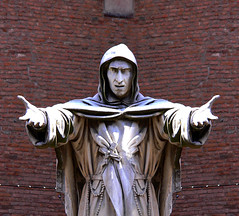Girolamo Savonarola (September 21, 1452 – May 23, 1498), also translated as Jerome Savonarola or Hieronymus Savonarola, was an Italian Dominican priest and leader of Florence from 1494 until his execution in 1498.
He was known for religious reform, anti-Renaissance preaching, book burning, and destruction of what he considered immoral art. He vehemently preached against what he saw as the moral corruption of the clergy, and his main opponent was Pope Alexander VI.
He is sometimes seen as a precursor of Martin Luther and the Protestant Reformation, though he remained a devout and pious Roman Catholic during his whole life.
In Florence, says Wikipedia, he began to preach passionately about the Last Days, accompanied by testimony about his visions and prophetic announcements of direct communications with God and the saints. Such fiery preaching was not uncommon at the time, but a series of circumstances quickly brought Savonarola great success. The first disaster to give credibility to Savonarola’s apocalyptic message was the Medici family's weakening grip on power owing to the French-Italian wars. The flowering of expensive Renaissance art and culture paid for by wealthy Italian families now seemed to mock the growing misery in Italy, creating a backlash of resentment among the people. The second disaster was the appearance of syphilis (or the “French pox”). Finally, the year 1500 was approaching, which may have brought about a mood of millennialism. In minds of many, the Last Days were impending and Savonarola was the prophet of the day.[1]
His Church of San Marco was crowded to over-flowing during his celebration of Mass and at his sermons. Savonarola was a preacher, not a theologian. He preached that Christian life involved being good and practicing the virtues, rather than religious pomp and ceremony. He did not seek to make war on the Church of Rome. Rather, he wanted to correct the transgressions of worldly popes and secularized members of the Papal Curia.
After Charles VIII of France invaded Florence in 1494, the ruling Medici were overthrown and Savonarola emerged as the new leader of the city, combining in himself the role of secular leader and priest. He set up a republic in Florence. Characterizing it as a “Christian and religious Republic,” one of its first acts was to make sodomy, previously punishable by fine, into a capital offence. Homosexuality had previously been tolerated in the city, and many homosexuals from the elite now chose to leave Florence. His chief enemies were the Duke of Milan and Pope Alexander VI, who issued numerous restraints against him, all of which were ignored.
In 1497, he and his followers carried out the Bonfire of the Vanities. They sent boys from door to door collecting items associated with moral laxity: mirrors, cosmetics, lewd pictures, pagan books, immoral sculptures (which he wanted to be transformed into statues of the saints and modest depictions of biblical scenes), gaming tables, chess pieces, lutes and other musical instruments, fine dresses, women’s hats, and the works of immoral and ancient poets, and burnt them all in a large pile in the Piazza della Signoria of Florence.[2] Many fine Florentine Renaissance artworks were lost in Savonarola’s notorious bonfires — including paintings by Sandro Botticelli, which he is alleged to have thrown into the fires himself.[3]
Florence soon became tired of Savonarola because of the city’s continual political and economic miseries partially derived from Savonarola's opposition to trading and making money. When a Franciscan preacher challenged him to a trial by fire in the city centre and he declined, his following began to dissipate.
Savonarola was faced with Papal charges such as heresy, uttering prophecies, sedition, and other crimes, called religious errors by the Borgia pope.
During the next few weeks he and two principal followers were tortured on the rack, the torturers sparing only Savonarola’s right arm in order that he might be able to sign his confession.
On the day of his execution he was taken out to the Piazza della Signoria along with Fra Silvestro and Fra Domenico da Pescia. The three were ritually stripped of their clerical vestments, degraded as "heretics and schismatics", and given over to the secular authorities to be burned. The three were hanged in chains from a single cross and an enormous fire was lit beneath them. They were thereby executed in the same place where the "Bonfire of the Vanities" had been lit, and in the same manner that Savonarola had condemned other criminals himself during his own reign in Florence.
Subscribe to:
Post Comments (Atom)





No comments:
Post a Comment